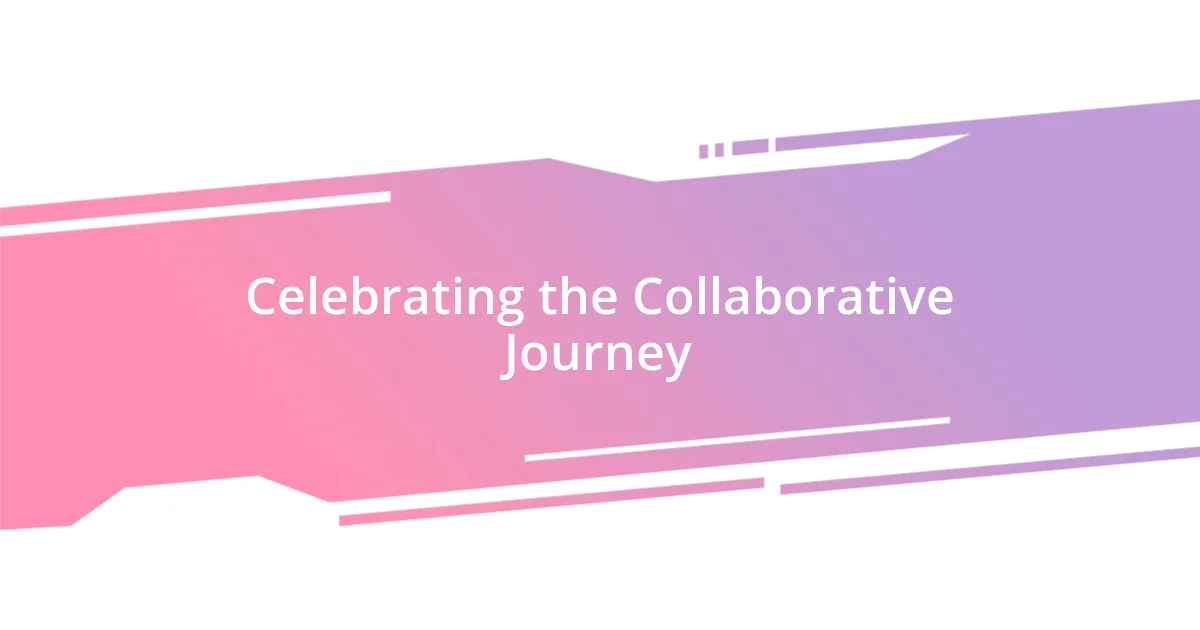Key takeaways:
- Effective communication is crucial in collaboration, involving regular check-ins, active listening, and clear expectations to foster creativity.
- Navigating creative differences enriches storytelling; embracing contrasting styles can lead to innovative and surprising outcomes.
- Celebrating the collaborative journey by acknowledging contributions and shared victories strengthens bonds and enhances the overall creative experience.

Introduction to Fantasy Collaboration
Collaborating with fantasy writers is like embarking on a thrilling adventure. I’ve found that weaving stories together opens up a world of creativity that I could never achieve alone. Have you ever felt that rush of ideas flowing when you bounce concepts off someone else? It’s exhilarating!
In my experience, collaboration in the fantasy genre often dives deep into uncharted territory. I once worked on a project where we created a shared universe, intertwining our characters and plots. The discussions were intense and full of laughter; we pushed each other to explore themes we hadn’t considered before. It made me realize how much richer stories can become through the melding of diverse minds.
Yet, collaboration can also come with its challenges. I remember moments of frustration when our visions didn’t align, but those moments taught me the importance of communication and compromise. How do we navigate these creative differences to strengthen our narratives? Each discussion, even the tough ones, has shaped my understanding of collaboration and forged lasting friendships built on our shared passion for storytelling.

Understanding Fantasy Writing Styles
Understanding the diverse writing styles in fantasy is key to effective collaboration. Each writer brings their unique voice, shaped by influences and personal experiences. For instance, I’ve worked alongside someone whose style was heavily inspired by classic mythology, crafting intricate plots and emotional depth. In contrast, another partner preferred a more whimsical approach, filled with quirky characters and lighthearted adventures. This blend not only enriched our stories but also taught me to appreciate different storytelling techniques.
I often wonder how styles impact reader engagement. When we collaborate, I notice how our various approaches can either clash or complement each other. For example, in one project, merging my darker, more serious themes with a collaborator’s playful tone led to fascinating dynamics in our narrative. The feedback we received highlighted this unique interplay, showing me the power of contrasting styles in captivating an audience’s imagination.
Ultimately, understanding these writing styles fosters a deeper connection among collaborators. Recognizing each other’s strengths and preferences can transform a project and make the writing process even more enjoyable. Have you ever been surprised by how much a different style can shift the perspective of a story? It’s moments like this that make collaborating with fantasy writers an enriching experience.
| Writing Style | Characteristics |
|---|---|
| Classic Mythology Inspired | Intricate plots, deep emotional themes |
| Whimsical | Quirky characters, lighthearted adventures |

Establishing Effective Communication
Establishing effective communication is the backbone of any successful collaboration. I’ve learned that clarity is vital, particularly when sharing ideas that can be wildly imaginative. I once experienced a moment of confusion during a brainstorming session when I assumed my collaborator understood my vision for a character. Instead, they painted a completely different picture! This miscommunication led to a constructive dialogue where we ultimately crafted a more cohesive character together, strengthening our narrative.
To foster effective communication, consider these strategies:
- Regular Check-Ins: Schedule consistent meetings to discuss progress and brainstorm.
- Active Listening: Make an effort to truly hear and understand each other’s ideas without jumping to conclusions.
- Clear Expectations: Outline goals and deadlines upfront to keep everyone on the same page.
- Encourage Openness: Create a safe space for sharing even the most unconventional ideas without judgment.
- Feedback Loops: Don’t hold back on constructive feedback, and be open to receiving it in return.
These practices have transformed my collaborations, allowing creativity to flourish even in the moments of uncertainty. It’s all about nurturing a space where everyone feels valued, which ultimately strengthens our stories.

Sharing Ideas and Inspiration
Sharing ideas and inspiration in collaboration can be truly magical. I remember one session where we all brought our favorite fantasy tropes to the table—a treasure trove of ideas! When one writer proposed a twist on the classic quest narrative, it ignited a passionate discussion that took our plot in unexpected directions. It’s fascinating how a simple suggestion can unleash waves of creativity among a diverse group of writers.
I often find that inspiration strikes in the most unexpected moments. While discussing world-building, one collaborator shared a childhood dream of exploring a landscape filled with floating islands. That dream transformed our setting into something breathtaking and unique. Have you ever had a seemingly trivial idea inspire a larger concept? I’ve discovered that embracing these sparks of inspiration can lead to profound narrative developments that resonate deeply with readers.
The essence of sharing ideas lies in vulnerability. When I hesitated to share my more outlandish concepts, one considerate partner encouraged me, reminding me that no idea is too wild in fantasy. That little nudge made all the difference. It’s essential, I believe, to create an environment where everyone feels free to express themselves. Isn’t that what collaboration is truly about—fostering a shared space for creativity to flourish?

Navigating Creative Differences
Navigating creative differences can be a delicate dance, and I’ve found that respect is the key to harmony. I once collaborated with a writer who had a very different approach to character development than I did. While I favored intricate backstories, they leaned towards spontaneous character arcs. This initially led to tension, but we soon realized the beauty in our conflicting styles. By incorporating both perspectives, we crafted characters with depth and authenticity that neither of us could have achieved alone. Have you ever faced a similar situation? Knowing how to blend contrasting ideas is crucial.
One memorable experience involved a debate over the direction of our story’s villain. I envisioned a morally ambiguous character, while my co-writer favored a traditional antagonistic role. Instead of letting our different viewpoints create disharmony, we scheduled a dedicated session to unpack our thoughts. We explored each other’s reasoning, leading to a hybrid villain that surprised us both. This collaboration not only enriched the narrative but also deepened our understanding of each other’s storytelling instincts. Isn’t it amazing how embracing each other’s differences can lead to unexpected breakthroughs?
Ultimately, navigating creative differences requires patience and open-hearted discussion. When I feel frustrated, I remind myself that collaboration is about discovering new horizons. I tend to approach disagreements with curiosity rather than defensiveness, which often transforms potential conflict into fertile ground for innovation. I think back to times when a clash of ideas opened the door to richer narratives. What if we viewed these moments as opportunities rather than obstacles? Challenging moments in collaboration can indeed lead to some of the most rewarding creative outcomes.

Finalizing Collaborative Projects
Finalizing collaborative projects is often where the magic truly happens. I remember a time when we gathered for a final review of our fantasy manuscript. As we read through it collectively, I felt a mix of excitement and anxiety—would everyone be satisfied with the direction we took? It was enlightening to see how minor adjustments could enhance our story, spotlighting the importance of collaboration in the editing process.
One key moment in finalizing our project arose when we debated over specific dialogue choices. I initially held firm to a certain character’s quirk, believing it added humor. However, upon listening to my co-writer’s perspective, I realized it detracted from the plot’s tension. Did I cling to this detail out of pride? Once I let it go, our narrative became more streamlined and engaging. It reinforced my belief that final decisions should reflect the story as a whole rather than individual preferences.
When wrapping up, celebrating our achievements is just as crucial as the editing phase. I suggested we create a shared document lined with our favorite lines and moments from the project. Everyone contributed, and seeing our unique touches distilled into something cohesive was fulfilling. What gets me at the end is the realization that every contribution, every compromise, has culminated in a story that genuinely belongs to all of us. Isn’t that a rewarding outcome of collaboration?

Celebrating the Collaborative Journey
Celebrating the collaborative journey isn’t just about the product—it’s truly about the bonds formed along the way. I’ll never forget a night spent brainstorming with my co-writer over coffee, surrounded by our chaotic notes and enthusiastic laughter. That sense of camaraderie made the entire creative process feel alive, turning those late-night debates into cherished memories. Have you ever felt that thrill when ideas bounce off one another like sparks in the dark? It energizes the project in ways you can’t predict at first.
On another occasion, as we put the finishing touches on our fantasy world, we took a moment to celebrate our progress with a little ritual. We shared our favorite scenes, reliving the excitement of what we created together. That simple act not only reinforced our partnership but also reminded us why we embarked on this journey in the first place. It’s those moments of acknowledgment and joy that forge a deeper connection—don’t you think it’s essential to honor those small victories?
Ultimately, I’ve learned that celebrating the collaborative journey transforms the often daunting task of creation into an enriching experience. Each draft and every revision became a point of reflection, allowing us to appreciate the challenges and triumphs together. That’s what keeps the spark alive—the shared acknowledgment of each step, no matter how big or small. What if we all took a moment to celebrate our own collective endeavors more often? The satisfaction found in celebrating our shared creative growth can be incredibly invigorating.














